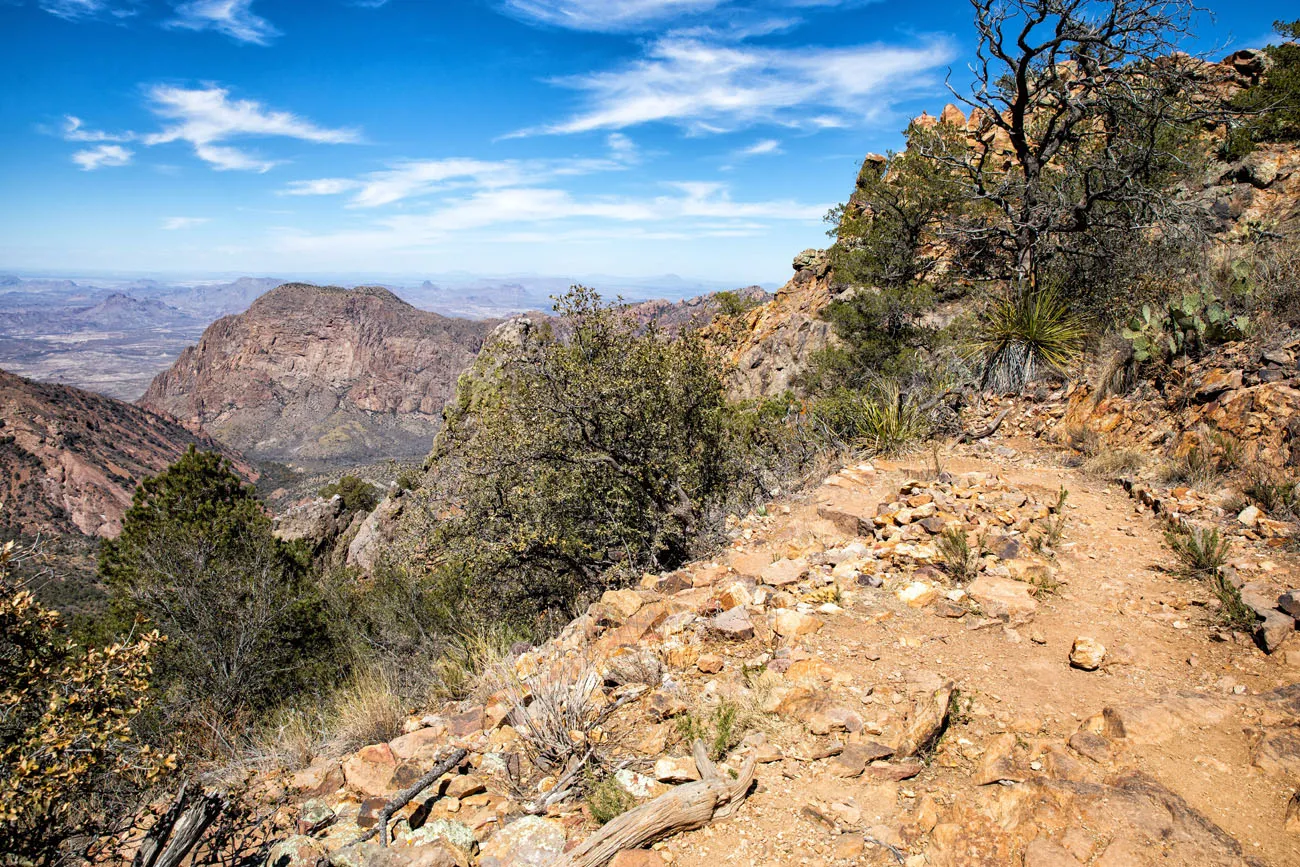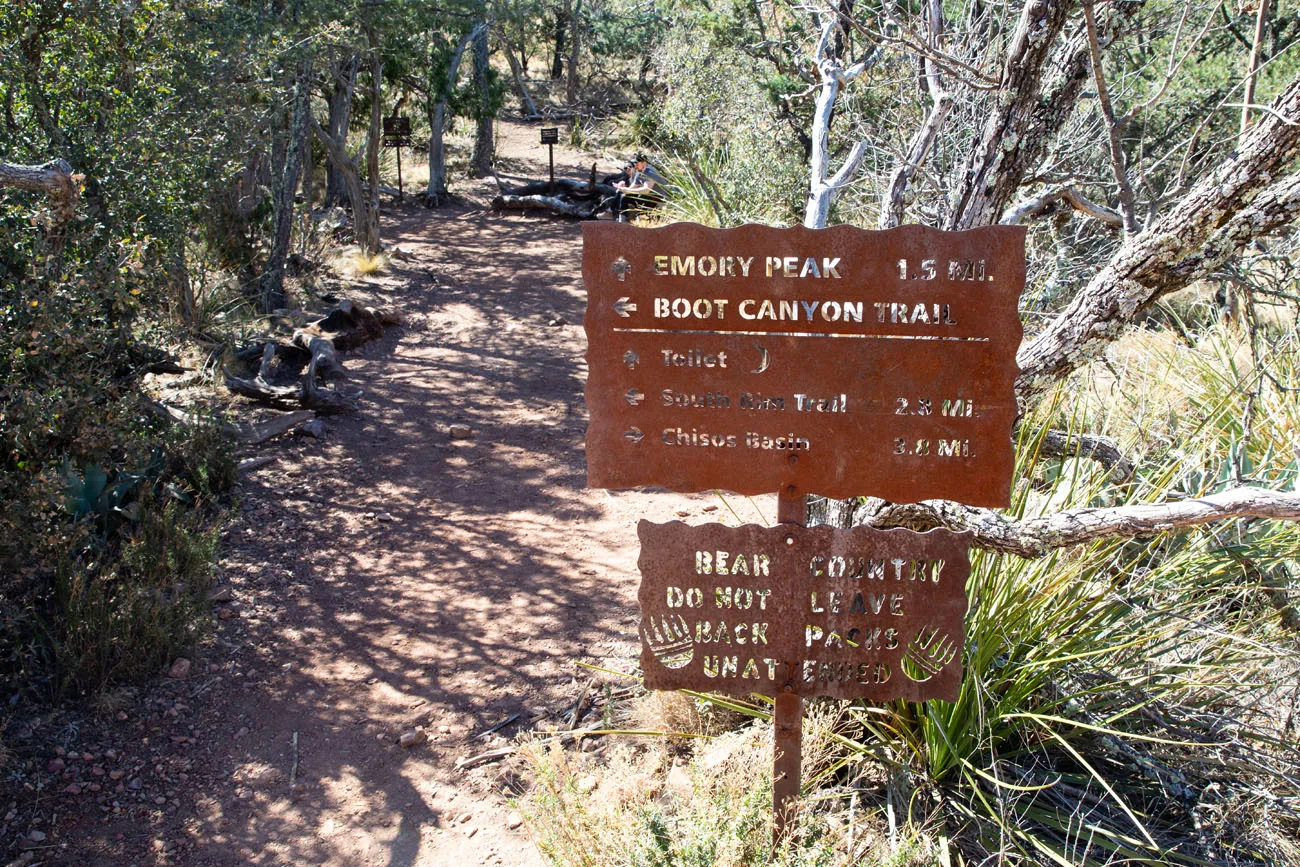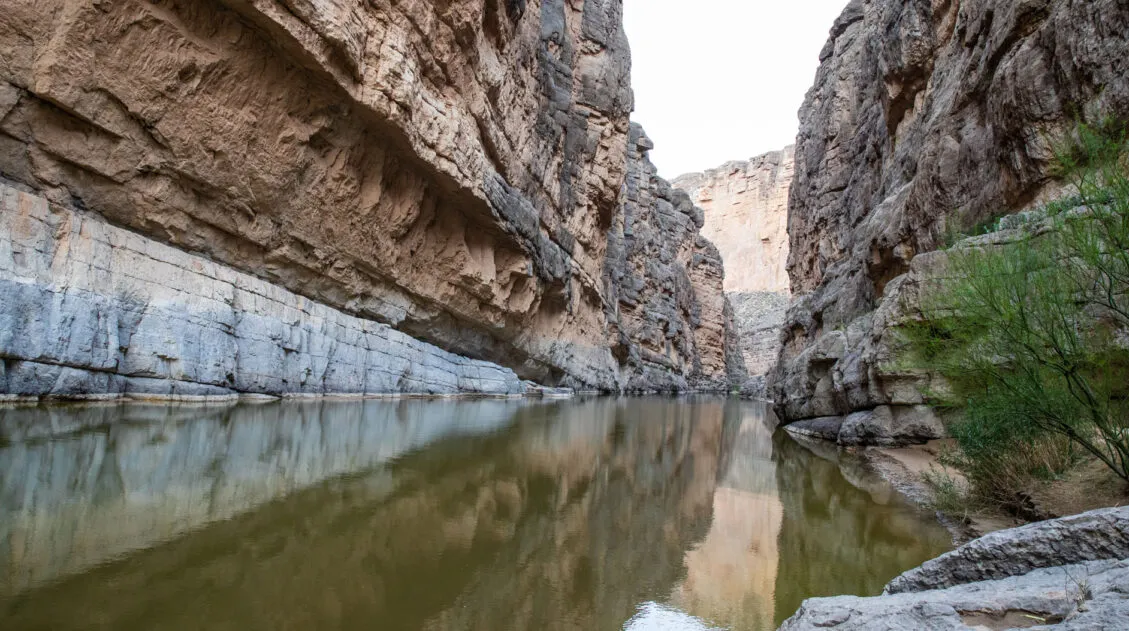Emory Peak is the highest peak in the Chisos Mountains and Big Bend National Park. It’s a tough hike to get here but the view over the park is unbeatable.
There are two different ways to do this hike. The quickest and most direct way is to hike out-and-back to Emory Peak from the Chisos Basin Visitor Center. Option #2, a full day adventure, is to hike the South Rim Trail and add on the detour to Emory Peak.
This post covers the out-and-back hike from the Chisos Visitor Center to Emory Peak. At the end of this post, I give a link to our separate article about the South Rim Hike with Emory Peak (or you can skip ahead to it now).
IMPORTANT: Starting May 2025, Chisos Basin will be closed for a construction project. This closure could include the trailhead for this hike. Get full details on the National Park Service website.
How to Hike to Emory Peak
Emory Peak Hiking Stats
Distance: 10.4 miles out-and-back
Total Ascent: 2440 feet
Difficulty: Strenuous
Length of Time: 5 to 7 hours

Please practice the seven principles of Leave No Trace: plan ahead, stay on the trail, pack out what you bring to the hiking trail, leave areas as you found them, minimize campfire impacts, be considerate of other hikers, and do not approach or feed wildlife.
Getting to the Trailhead
This hike starts and ends at the Chisos Basin Visitor Center. There is a large parking lot here but it can fill up early. I recommend arriving around sunrise, in order to get a parking spot, and to start your hike in the morning, while temperatures are still cool.
There are several trails that start next to the Chisos Basin parking lot (the Window Trail, the Window View Trail, and the Laguna Meadows Trail). From the parking lot, look for the sidewalk that leads to the hiking trails.

Chisos Basin Trailhead. The trail to the left leads to Emory Peak. The trail to the right is the Window View Trail.
For this hike, follow the signs for Emory Peak. Hike the Laguna Meadows Trail for roughly 0.3 miles until you come to a fork in the trail. Take the trail to the left, following the signs to Emory Peak. This is called the Pinnacles Trail.

The Pinnacles Trail
The first mile of the Pinnacles Trail isn’t too strenuous. But that giant peak looming in front of you…that’s your end goal. It looks unbelievably high. And it might feel that way, especially by the time you approach the top.
The Pinnacles Trail steadily gains elevation. Near the end of this trail you will hit the switchbacks and this is where it gets to be more challenging.
The Pinnacles Trail ends at the saddle that sits at the base of Emory Peak. From here, take the Emory Peak Trail. The second trail, the Boot Canyon Trail, leads out to the South Rim.

On the Pinnacles Trail (the view along the trail on the way back to Chisos Basin).

View from the saddle, at the start of the Emory Peak Trail.
Emory Peak Trail
At the saddle, there is a toilet as well as bear boxes, large boxes where you can store your backpacks, if you don’t want to lug them the rest of the way up the mountain.

From this point, it is a 1.5-mile hike to Emory Peak with approximately 1,000 feet of elevation gain. It is uphill the entire way.

On the Emory Peak Trail, with Emory Peak in the distance.
The trail ends with a 25-foot rock scrambling section to get up onto the peak. If you like rock scrambling, you’ll love this part of the hike. But if you have a fear of heights or climbing up and down massive boulders, this final section can be intimidating.


This is looking down from the top of Emory Peak at the final section of rock scrambling.
From Emory Peak, enjoy the spectacular 360° views over Big Basin National Park. On a clear day, you can see the Chihuahuan Desert and the entire Chisos Mountain Range.



The view over Chisos Basin. If you look carefully, you can see the Chisos Basin visitor center and lodge.
Retrace your steps back to the visitor center.
Summary: Chisos Basin parking lot -> Laguna Meadows Trail (0.3 miles) -> Pinnacles Trail (3.4 miles) -> Emory Peak Trail (1.5 miles)
South Rim Trail + Emory Peak
This is a loop hike that starts and ends in Chisos Basin. This is a much longer and more challenging hike than the out-and-back hike described above. However, the views from the South Rim are amazing. If you already have plans to hike the South Rim Trail, adding on the hike to Emory Peak adds about 3 miles and 1.5 hours to your day.

You can do this loop in either direction. We hiked it counter-clockwise, hiking the South Rim Trail first and then adding on Emory Peak as we headed back to the Visitor Center.
Distance: 15.6 miles
Total Ascent: 3640 feet
Difficulty: Strenuous
Length of Time: 8 to 10 hours
For more information about how to combine these two hikes, read our detailed guide on the South Rim Trail ↓
South Rim Trail Loop + Emory Peak | Ultimate Hiking Guide
Everything you need to know to hike the South Rim Trail and add on Emory Peak.Tips to Have the Best Experience
Start early in the day. This is a very long hike, so ideally, start at sunrise to give yourself enough time to complete this hike. Starting early will also let you get the most strenuous part of the hike, the ascent up to Emory Peak, finished before temperatures really heat up.
Bring lots of water. During the warmer months, 4 liters per person is recommended.
Bring sunblock. There is very little shade on the trail.
Check in the Visitor Center and/or the National Park Service website about trail closures before you go.
There is a chance you could cross paths with a black bear or a mountain lion. Click the links for advice from the NPS website on what to do should you encounter one of these animals on the hiking trail.
If you have any questions about hiking to Emory Peak, or if you want to share your experience, let us know in the comment section below.
More Information about Big Bend National Park
Read all of our articles about Texas in our Texas Travel Guide and the USA in our United States Travel Guide.


















Comments 4